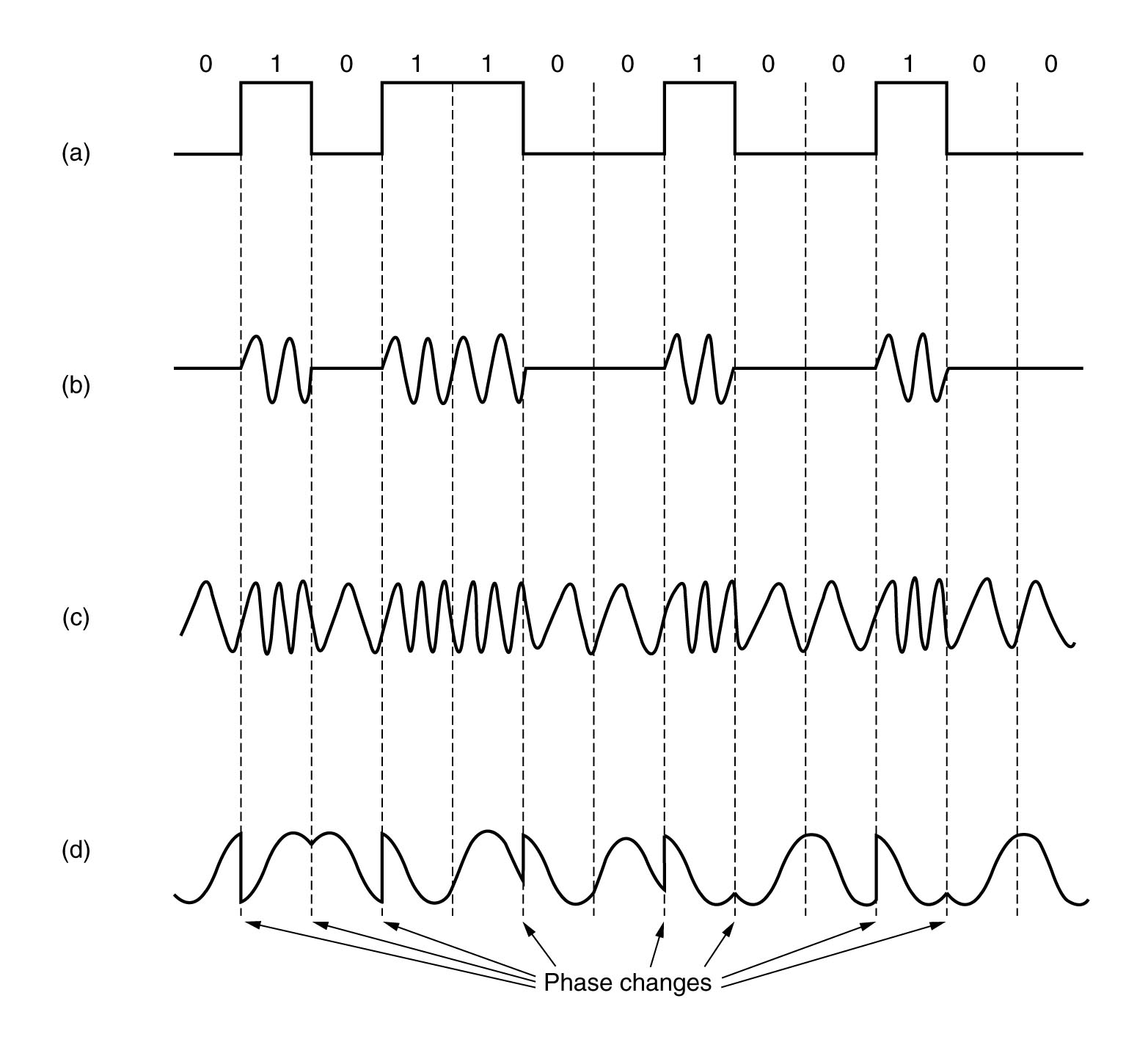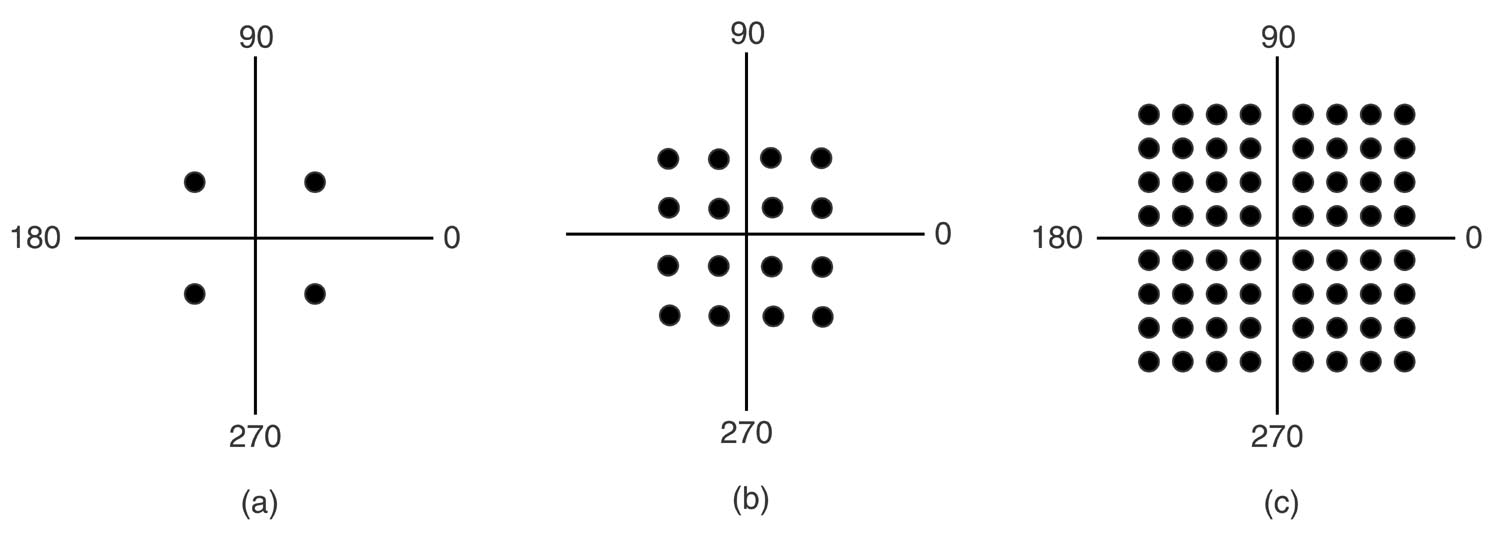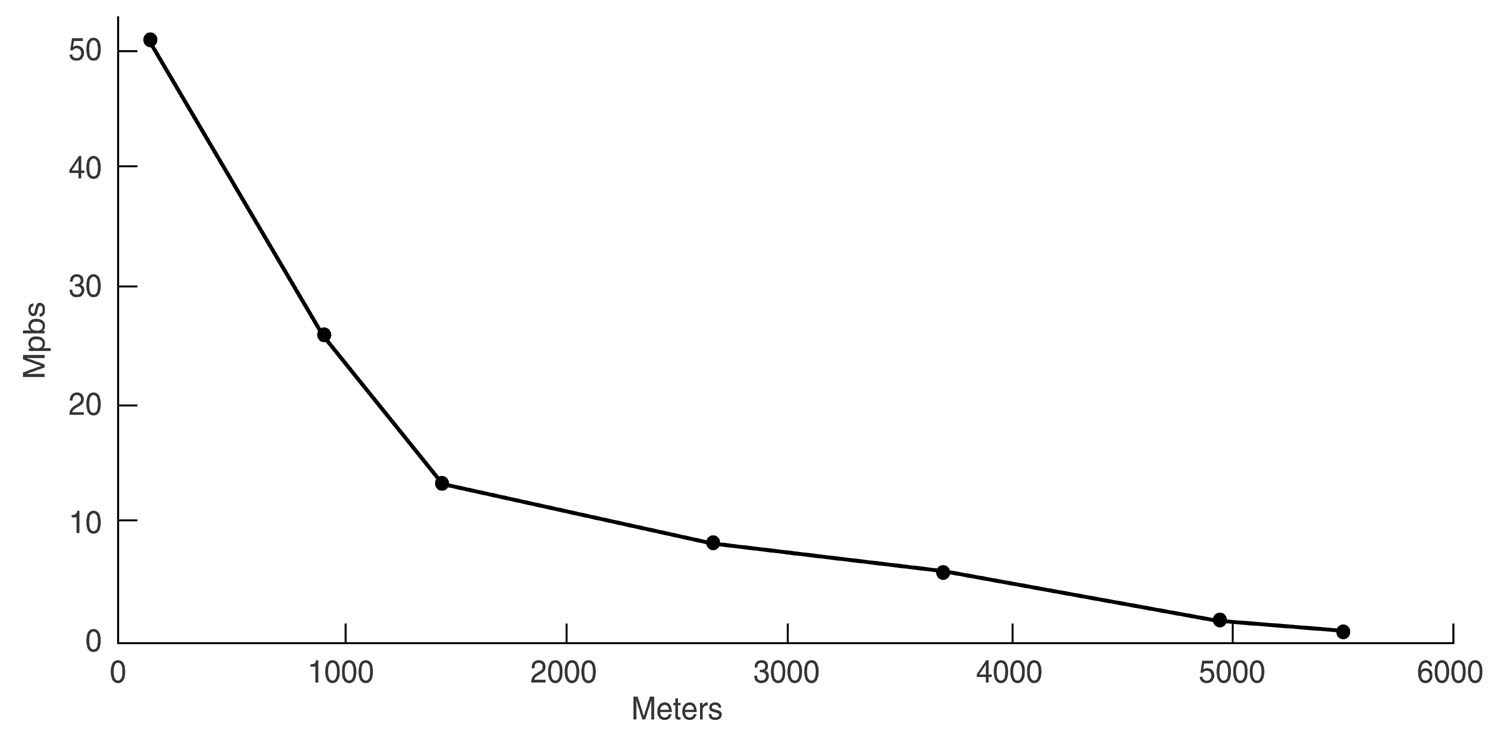Phone lines
Modems
DSL
Irish broadband speeds
bandwidth speed tests
2.2.2 Twisted pair (phone line)

(a) Older version.
(b) Newer version.
2 insulated copper wires.
Twisted as helix - interference from different twists cancels out.
Can run several km before need amplification.
Change voltage
(or current)
on the line
to give analog signal changing over time.
Analog signal may map directly to analog sound output (phone call).
Line frequency
(voltage change over time)
maps direct to sound frequency
(audio change over time),
since voltage changes in real time as audio changes.
Or analog signal can be quantised to carry information (modem).
The local loop
- Telephone network - The local loop
("the last mile"
connecting your house to nearest phone company "end office")
- Uses twisted pair.
- Still analog.
- Telephone network - The backbone
- Uses coax (not much any more), fiber optic (mostly now)
and wireless (microwave, often useful alternative to fiber).
- All-digital.
Twisted pair not going away any time soon
Twisted pair still has
enormous installed base.
Not going away any time soon.
Easy to upgrade telephone HQ. Not easy to upgrade every house.
So use methods to squeeze maximum possible performance out of these old lines.
Basic speed 2400 bps.
Clever coding
used to get up to 56 kbps.
Unused frequencies used in
DSL broadband
to get even higher speeds.
The
"last mile"
is (usually) analog.
To send data, must convert digital to analog.
Done by
modem
(modulator - demodulator).
Telephone system originally designed for analog voice.
Now telephone system designed for digital.
Except at local loop.
Telephone backbone - ISP - Internet backbone -
remote web server, etc., all-digital.

Analog-digital conversion needed at local loop.
After that, usually all-digital (ISP 2).
ISP 1 (on analog local loop) doesn't exist any more.
Modulation

Forms of
modulation.
(a) The binary signal we are trying to represent.
(b) Amplitude modulation.
One amplitude is 0. One non-zero.
(c) Frequency modulation.
2 frequencies used.
(d) Phase modulation.
Constant frequency.
But the carrier wave is shifted by n degrees (e.g. 180 degrees).
A phase shift indicates a change from 1 to 0, or 0 to 1.
No phase shift indicates no change.
Modems on a standard telephone line
Telephone line
baud v. bps
baud
- No. of samples per second.
Standard modem - 2400 baud.
Given the limited bandwidth (range of f's) of the phone line,
it is actually
pointless to sample
much more often than this.
Clever coding
may mean each sample (each "symbol")
yields multiple bits.
So bits per second
= some multiple (typically from 1 to up to 16) of baud.
Example:
Alter voltage to 0,1,2 or 3 volts.
Then each symbol (voltage sample) contains 2 bits
(00, 01, 10, 11).
2400 baud. 4800 bps.
Why not 1000 different voltage settings?
See problems of pure (continuous) analog transmission.
As we add more symbols,
noise
can more easily change from one symbol
to another.
So as we add more symbols,
modems introduce error-detection (see below).
In general, 2n possible symbols
means each symbol can represent n bits,
so:
bps = n . baud
- Phase
- Amplitude
- Frequency
-
Different frequencies commonly not used for modulation,
but used to have 2-way transmission on same line
(all modern modems).
Constellation diagram of the modem

Amplitude (distance of point from origin)
and phase (angle of line from point to origin) modulation.
(a) QPSK - 4 phase shifts
- 4 symbols = 22
- bps = 2 .baud
- 4800 bps on 2400 baud
(b) QAM-16.
- 16 symbols = 24
- bps = 4 .baud
- 9600 bps on 2400 baud
(c) QAM-64.
- 64 symbols = 26
- bps = 6 .baud
- 14.4 kbps on 2400 baud
Error detection
As discussed, more symbols means more likely that error transforms
into wrong symbol (compare with just 0 and 1).
So more advanced modems add error-detection.
Add extra bits to signal.
The V.32 modem standard
uses 32 symbols, represent 5 bits.
Each is 4 data bits plus 1 parity bit.
9600 bps with error detection.
Even parity bit: Make the number of 1s even:
- Data: 1010. Sent: 10100
- Data: 1000. Sent: 10001
Easy to detect 1-bit error (will get odd parity).
Can't detect 2-bit error.
All error-detection and correction methods only work below a certain error rate
V.32 and V.32 bis

(a) V.32. 4 data bits. 1 parity. 9600 bps.
(b) V.32 bis. 6 data bits. 1 parity. 14.4 kbps.
V.34 bis gets 14 data bits/symbol. 33.6 kbps.
Beyond that, modems
compress
before transmitting,
to get effective data rate higher.
e.g.
V.44 compression
is based on the common
LZW lossless
data compression algorithm.
Sometimes, the telephone line isn't of sufficient quality to use higher standards.
Modems test the line (may take 15-30 sec),
and cut back to simpler (slower) standard.
Limits (for ordinary phone line)
If machine at other end is
also on analog local loop (e.g. some P2P sessions),
theoretical limit is about 35 kbps
(2 loops add noise rather than one).
If machine at other end is pure-digital (e.g. all Web sites),
theoretical limit is about 70 kbps.
V.92
final standard 1999 (before DSL broadband took over)
- 48 k upstream, 56 k downstream.
May not work for you -
Many local loops are too noisy even for 33.6 k.
DSL - Broadband on phone line
Telephone designed for analog human voice.
No point transmitting frequencies that will be transformed
by analog reader into sound
outside human voice range.
In fact, don't
want to.
So local loop has filter (at end office) which
deliberately
attenuates frequencies
below 300 Hz, above 3400 Hz.
What this means is that your telephone line
has a filter put in to deliberately restrict
its bandwidth.
Don't care about 0 to 300 Hz.
Care about 3400 Hz to 1.1 MHz.
DSL - Arrange with your end office to remove the filter.
Transmit those f's to your DSL modem, which can use them.
1.1 MHz spectrum now available.
Other existing equipment (e.g. your regular phone)
can't deal with these f's,
so you must add a filter in your house to all existing equipment
(just plug it into filter, plug filter into telephone socket).
Can now
self-install
(compare with Internet on cable TV).
Theoretical DSL bandwidth
 Theoretical
Theoretical bandwidth for DSL circa 2003.
Mpbs should read Mbps.
Higher bandwidth achieved since:
VDSL2
has
theoretical max speed 250 M bps.
Bandwidth falls off with distance from end office.
In practice, many problems. Speeds may be lower.

The fastest speed I've seen so far
on my home Internet access.
(Home TV cable.)
Tested
here.

The fastest speed I've seen so far
on my work Internet access.
(Irish universities network.)
Tested here.
ComReg report
- ComReg
- Q4 2008 report:

- This shows:
- 660,000 DSL broadband.
- 309,000 mobile phone network broadband.
- 237,000 narrowband (dialup).
- 118,000 fixed wireless broadband.
- 104,000 TV cable broadband.
- 9,000 other broadband (satellite, fiber)
Fastest broadband in Ireland
Broadband speeds in other countries
- DSL can deliver 100 M on a phone line
- Fiber to the home
not needed!
- VDSL - 52 M
- already running in some countries worldwide.
- VDSL2 - 100 M
- Note fiber speeds are still higher:
- World broadband speeds 2007:
 Japan and South Korea both have average household speeds over 40 M.
Ireland's average is 2 M.
Japan and South Korea both have average household speeds over 40 M.
Ireland's average is 2 M.
I first surfed the Internet
from home 20 years ago at
2 k if I was lucky,
but often
1 k.
This was fast enough for (entirely text-based) email, discussion lists,
online chat, file downloads,
online publishing
and even remote editing.
I am now on
at home at
100 M - 100,000 times faster.
Quite likely within the next 20 years I will be on
at home at
10 G - 10 million times faster.
DSL phone line spectrum
1.1 MHz spectrum available:
Typically divided into 256 channels, some for upstream, some for downstream,
one (0 to 4000 Hz) for old phone calls:

Phone and DSL co-exist on same line.
Many similar issues to old regular modem on phone line:
- Sample line for quality. Adjust data rate.
- QAM modulation.
250 QAM modems operating in parallel at different frequencies.
Future of the phone line
Old phone line use may become obsolete
(same hardware, different use):








